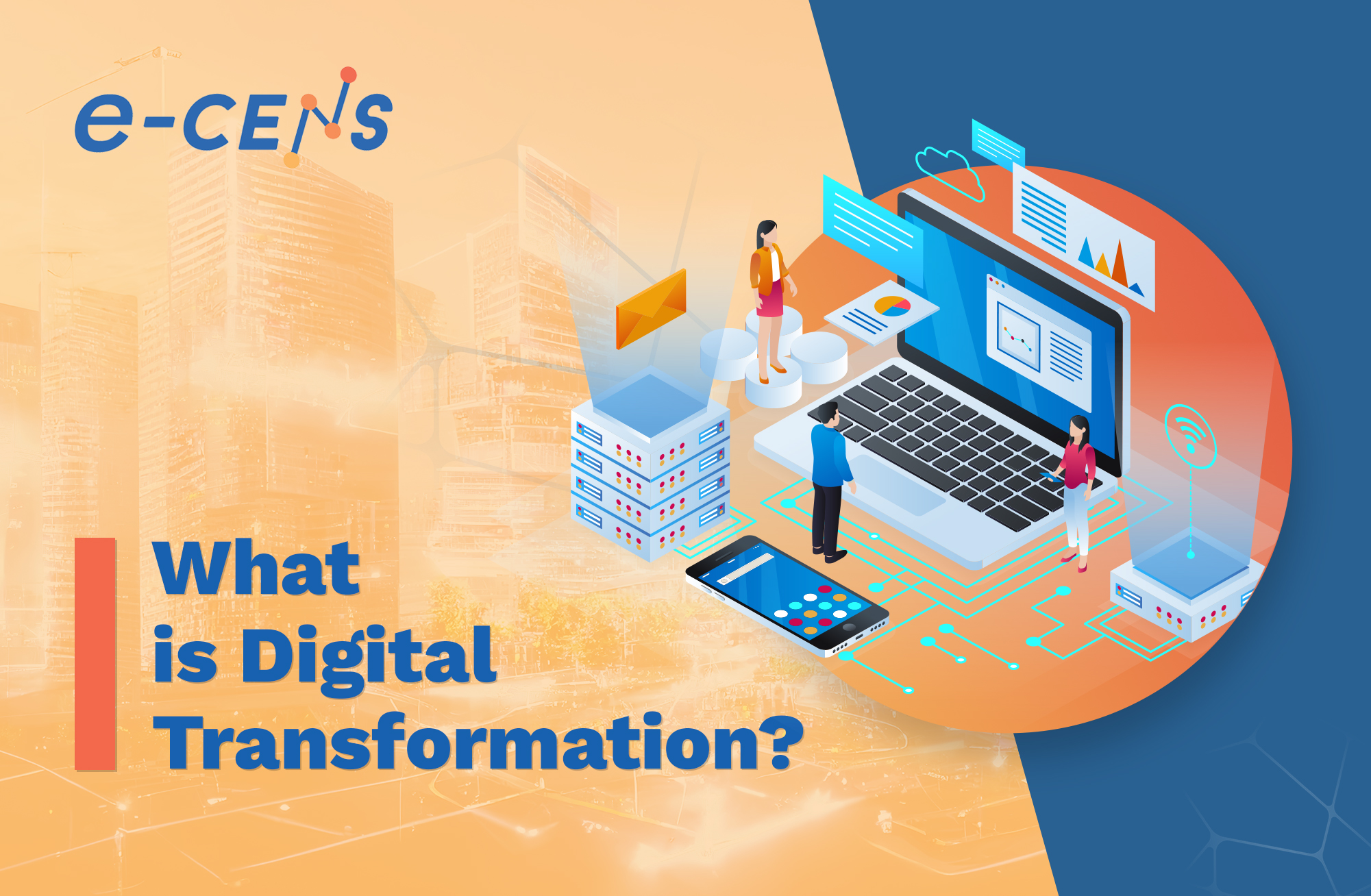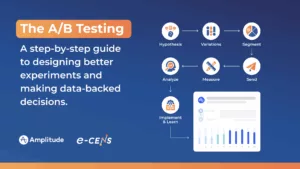What is The Definition of Digital Transformation?
Well, it depends.
So, in recent years, digital transformation has become a big thing where people use digital technologies to improve things for customers, help out employees, make business operations smoother, and add value to organizations. It’s all about revamping old processes or developing new services using digital technologies.

Table of Contents
In E-CENS, we have a definition that addresses the new change in the digital world from the perspective of marketers, digital analysts, and customer engagement, which is:
“Digital transformation is an intentional change to advance an organization’s digital maturity. It involves utilizing digital technologies to fundamentally alter business operations, deliver enhanced customer experience, and remain competitive in the market.”
This process entails adopting new technologies, evaluating business models, enhancing the skills and expertise of your people, and restructuring processes to leverage the opportunities presented by digital advancements. This process can include integrating digital platforms, data analytics, increased automation, and artificial intelligence into various aspects of operations to enhance efficiency, improve measurement, and optimize media effectiveness.
Now, many people can’t exactly pinpoint why digital transformation is essential, and I don’t blame them because if you asked ten people, you’d probably get ten different answers.
But I managed to sum it all up for you.
Why is Digital Transformation Important?

Digital transformation is essential for staying up-to-date and not falling behind competitors. With technological advances and the increasing use of digital channels, companies have to adapt and transform their operations to meet their customers’ changing needs and expectations.
According to Deloitte’s report, by implementing a strategic blend of digital transformation initiatives, Fortune 500 companies have the potential to increase their market capitalization by as much as US$1.25 trillion.
The enterprise landscape has changed considerably over the last two decades, and the pace of change is accelerating. From the standpoint of today’s digital enterprises, some key challenges are emerging related to activating media, measuring outcomes, and providing a seamless customer experience across the entire life cycle.
- Signal loss due to privacy and consent regulations
- Signal loss due to proactive industry responses, such as browser and mobile app tracking prevention functionality and the looming deprecation of third-party cookies
- Rising consumer expectations around seamless, personalized experiences and communications
Of course, there are plenty of opportunities, too:
- Increased ability to utilize zero- and first-party data for media activation, measurement, customer engagement, and digital experience delivery
- Brands that build trust and deliver on the promise of connected, multi-moment marketing and digital experience will continue to stand out head and shoulders above competitors.
- Computational power is at an all-time high, along with the availability of powerful cloud-based data ecosystems with tons of built-in AI, ML, and general querying power.
That’s especially true after the COVID-19 era, where everyone who wasn’t ready for an all-digital world was shocked, and a lot went out of business!
For example, implementing digital tools for inventory management can help businesses track and manage their stock more effectively, minimizing the risk of overstocking or running out of products. This not only improves operational efficiency but also helps optimize costs and resources.
Digital transformation encompasses more than just improving efficiency; it also focuses on enhancing customer experiences. In today’s digitally connected world, consumers expect seamless and personalized interactions.
This holistic approach to digital transformation enables businesses to achieve customer engagement, enhanced media and behavioral measurement, better marketing and advertising strategies, and increased customer insights.
Most people owning smartphones and accessing the internet have the world at their fingertips. They expect businesses to match their digital savviness, offering personalized, seamless online experiences.
This helps companies stay connected with their customers and allows them to gather feedback and improve their products and services based on customer insights.
The Benefits of Digital Transformation
When I asked Patrick Soch, our digital transformation expert, about his input of what are the benefits of digital transformation, he highlighted several benefits:
- Increases capabilities to deliver personalized and seamless customer experiences.
- Advances capacity to activate media, target audiences, measure the impact of marketing and advertising, and optimize business objectives.
- Achieves more connected, data-centric, and data-driven marketing.
- Realizes double-digit improvements in both media efficiency and media effectiveness.
- Increases sales or qualified lead pipeline at a lower cost per acquisition.
- Assists an organization in responding to regulatory issues related to privacy, consent, data usage, and shifting consumer expectations.
- Unlocks the power of consent, privacy-friendly first-party data strategies
What are the key trends in digital transformation in 2023?
It depends on the industry in which the trend is gaining traction; AI & ML have been taking the world by storm, but not every industry will experience the same trends, and sometimes they might experience multiple trends simultaneously.
Here are some of the most popular trends that popped up in 2023:
1- CEPs: Digital transformation is centered around delivering personalized, seamless, and omnichannel customer experiences. Organizations use customer engagement platforms (CEPs), such as MoEngage, to understand customer preferences better and provide optimized messaging aligned to platform/channel, messaging, frequency, offers, and topicality. Along with customer/digital experience platforms and customer data platforms (CDPs), this trifecta of technologies is emerging as a clear focus for priority investments by many clients in retail/ecommerce, travel & hospitality, and many other industries.
2- Composability: One of the new trends you’ll have to look for is composability and its role in digital transformation. We’ve written a blog about composable tech that goes into more detail about this subject. Designing a composable architecture has a ton of value, but development resources are required to make it all work. It’s not suitable for everyone, but for companies that get it right, there’s undoubtedly some magic at work!
3- Artificial Intelligence (AI) and Machine Learning (ML): As organizations collect vast amounts of data, AI and ML technologies are used to analyze and make sense of this data. These technologies are used for tasks such as predictive analytics, automation of repetitive tasks, and personalized customer experiences. Enterprises can generate actionable insights, campaign triggers, and refined audience strategies by incorporating first-party customer data, media performance data, and massive public data sources.
4- Cloud Computing: Cloud technology allows organizations to store, access, and process data and applications over the internet. It provides flexibility, scalability, and cost-effectiveness, enabling digital transformation initiatives across various industries.
5- Cybersecurity and Data Privacy: With increased digitization comes a higher risk of cyber threats. Organizations prioritize cybersecurity and data privacy to protect sensitive information and maintain customer trust.
6- Digital skillset and talent transformation: With the rapid pace of digital transformation, organizations need to upskill and reskill their workforce to keep up with evolving technologies. This includes training employees in digital literacy, data analytics, AI, and other emerging skills.
7- Digital partnerships and ecosystems: Collaboration with technology partners, startups, and other industry players is crucial for successful digital transformation. Organizations are forming strategic partnerships and building ecosystems to leverage each other’s expertise, innovation, and customer base.
How Can I Measure ROI on Digital Transformation?

Measuring the Return on Investment (ROI) on digital transformation can be challenging due to numerous intangible factors. However, the following approaches can assist you in gauging the ROI on digital transformation:
- Define Key Performance Indicators (KPIs): Identify specific KPIs that align with your digital transformation goals. These could include increased revenue, improved customer satisfaction, reduced operational costs, or enhanced productivity.
- Establish Baseline Measurements: Determine baseline measurements for each identified KPI before implementing digital transformation initiatives. This will enable you to compare the effects of your transformation efforts before and after implementation.
- Track Costs: Keep a record of the costs associated with digital transformation, including technology investments, personnel training, software licensing, and other relevant expenses.
- Monitor Performance Metrics: Regularly measure and monitor your KPIs to assess the impact of digital transformation. Utilize analytics tools to gather and analyze data related to customer behavior, operational efficiency, revenue growth, and other pertinent metrics.
Remember, too, that digital transformation engages in holistic organizational change. In assessing both the cost of the investment and the ROI, it is essential to think broadly (but not so broadly that you cannot make reasonable estimates/calculations):
Investments:
- Technology
- Data Storage & Querying Costs
- Integration, Implementation, and Development
- Change Management, Onboarding, and Training
Returns/Benefits:
- Operational Efficiency
- Errors & Omissions Reductions
- Media Effectiveness
- Media Efficiency
- Website/Mobile App Performance
- Customer Engagement Channel Performance (or Lead-to-Close Performance for B2B contexts)
- Churn Reduction
Conduct Surveys and Collect Feedback: Request employees, partners, and customers to provide feedback on the digital transformation initiatives. Gather their opinions on how these initiatives have improved their experiences, streamlined processes, or enhanced collaboration. This qualitative information serves to supplement quantitative metrics.
Calculate Financial Metrics: Determine financial metrics like ROI, Net Present Value (NPV), or Payback Period. These metrics aid in quantifying the financial benefits derived from digital transformation initiatives.
Continually Assess: Digital transformation is a continual process. Regularly evaluate the impacts of ongoing initiatives to ensure alignment with your business goals, adjusting your strategies as necessary to enhance ROI and overall success.
Remember that ROI measurement for digital transformation might not always be straightforward due to intangible benefits, long-term impacts, and potential market changes. Therefore, it’s crucial to consider a combination of both quantitative and qualitative approaches for a comprehensive understanding of your ROI.
How Has the Covid-19 Pandemic Changed Digital Transformation?
The COVID-19 pandemic has greatly accelerated digital transformation across various sectors. Here are some fundamental changes:
1. Remote Work: The pandemic has forced organizations to quickly adopt remote work setups, leading to increased reliance on technology tools for communication, collaboration, and workflow management. This has led to the widespread adoption of teleconferencing tools, cloud-based file storage, project management software, and other digital solutions.
2. E-commerce and Digital Services: As lockdowns and social distancing measures restricted physical interactions, there has been a significant shift towards online shopping, contactless payments, and digital service delivery. Businesses that previously relied on physical footprints were compelled to establish or enhance their online presence quickly. Equally important, in many sectors, consumer expectations have quickly shifted to an expectation around certain kinds of services for convenience that were available but not so ubiquitous five years ago.
3. Digitization of Processes: To mitigate disruptions, businesses have expedited the digitization of various processes. This includes moving to cloud-based systems, automating workflows, and leveraging artificial intelligence (AI) and robotic process automation (RPA) to streamline operations, enhance efficiency, and reduce dependence on manual tasks.
4. Online Education and Virtual Events: With schools and universities closing, there was a sudden surge in online education platforms and virtual learning tools. Similarly, conferences, seminars, and events transitioned to virtual formats, leading to the rise in virtual event platforms, webinars, and online networking tools. In-person events, meetings, and a slow return-to-office are all increasing, but it will be an exciting trend to watch to see where a new equilibrium is established. One thing is for sure: There will be a significant and likely growing opportunity for quality virtual events and education delivery in online-only formats.
5. Telehealth and Remote Healthcare: The pandemic has accelerated the adoption of telehealth technologies, allowing patients to consult doctors remotely. Remote monitoring and wearable devices have also gained prominence for managing chronic conditions and reducing in-person healthcare visits. This trend will continue to grow along with the push to reduce cost-to-deliver metrics across healthcare sectors. Investments by Google, Amazon, and others around healthcare-specific cloud-based data and SaaS tools should indicate the momentum around digitization in healthcare generally.
6. Data and Analytics: The increased integration of internet-based technologies has generated vast data. Businesses utilize analytics and artificial intelligence (AI) to gain insights, identify patterns, and make data-driven decisions to address challenges, adapt to changing market conditions, and optimize operations. Most enterprise martech suites, such as Google Marketing Platform, Salesforce Marketing Cloud, and Adobe, incorporate native AI and ML-derived insights directly into their platforms to deliver near real-time anomaly detection and data-informed automated or recommended optimization changes.
Now comes the big question: How do you start with digital transformation?
How Can I Get Started on Digital Transformation?
To get started on digital transformation, you can follow these steps:
1. Define your goals: Identify the specific objectives you want to achieve through digital transformation. Determine how you want to improve your organization’s operations, customer experience, or other areas.
2. Assess your current capabilities: Evaluate your existing technology infrastructure, systems, and processes. Understand the strengths and weaknesses of your current state to determine what needs to change and what can be used.
3. Create a digital strategy: Develop a comprehensive strategy outlining how to achieve your digital transformation goals. Consider technology adoption, data management, talent acquisition, and partnerships.
4. Secure executive sponsorship: Gain support from top-level executives who can champion the digital transformation initiative. This will ensure you have the necessary resources, authority, and visibility to drive the change.
5. Build a cross-functional team: Assemble a team with a broad range of skills and expertise from different departments to collaborate on the transformation journey. This team will oversee the planning, execution, and management of the digital transformation projects.
6. Identify quick wins: Start with small, manageable projects with tangible outcomes. These quick wins help build momentum, gain early success, and generate buy-in from stakeholders.
7. Invest in technology: Identify the right digital tools and solutions that align with your goals and strategy. Evaluate different software, platforms, and systems to find those that will support your transformation efforts effectively.
8. Develop a change management plan: Digital transformation often involves significant organizational change. Develop a plan to effectively communicate and manage this change, considering training, adoption, resistance management, and ongoing employee support.
9. Start the journey: Begin implementing the digital transformation initiatives and projects identified in your strategy. Monitor progress, measure results, and adjust to stay on track.
10. Foster a culture of continuous improvement: Embrace a continuous learning mindset and adaptability to evolve and innovate continually. Encourage experimentation, collaboration, and feedback, and continuously evaluate and iterate on your digital transformation efforts.
Lastly, remember that digital transformation is an ongoing process that requires ongoing commitment, monitoring, and adjustment to keep pace with the evolving technology landscape and market demands.
What are Some Examples of Digital Transformation?
One of the most important examples of digital transformation is the retail industry.
Traditionally, brick-and-mortar stores relied on physical interactions between customers and sales representatives.
With digital transformation, retailers have embraced e-commerce platforms, enabling customers to browse and purchase products online. This shift has expanded their customer base and provided convenience, accessibility, and personalized shopping experiences.
Digital transformation in retail also extends to supply chain management. Retailers are adopting advanced analytics and Internet of Things (IoT) technologies to gain real-time insights into inventory levels, demand patterns, and customer preferences.
This data-driven approach allows retailers to optimize their inventory, reduce waste, and improve product availability, ultimately enhancing customer satisfaction.
Moreover, digital transformation has revolutionized customer engagement through various digital channels.
Retailers now utilize CEPs (Customer engagement platforms) like MoEngage to interact with customers, understand their needs, and provide personalized offers and recommendations to each customer through their preferred channels.
Beyond the crucial and straightforward step of respecting and honoring each customer’s contact preferences, these platforms also utilize data-driven insights to optimize engagement channels to help reduce churn, enhance loyalty, and increase customer lifetime value.
Mobile apps and loyalty programs also enable retailers to offer targeted promotions and rewards, fostering long-term customer relationships.
Another industry significantly impacted by digital transformation is finance. Online banking and mobile payment solutions have transformed how individuals manage their finances.
Customers can now perform transactions, check account balances, and access financial services conveniently through digital platforms.
This shift has significantly reduced the need for physical branch visits while enhancing the accessibility and speed of financial transactions.
Furthermore, digital transformation has enabled financial institutions to leverage big data and artificial intelligence (AI) algorithms for risk assessment and fraud detection.
These technologies analyze vast amounts of data in real-time, allowing banks to identify potential risks and suspicious activities more efficiently. Consequently, this improves security measures and protects customer assets.
Simple tasks like siting a check can be sited virtually via a mobile phone app. It pays to remember how recently this was a ‘new’ option for consumers.
Conclusion
Look at reports of the digital landscape by McKinsey, Gartner, or Deloitte. You’ll find a massive shift toward making everything as digital as possible, and that’s expected due to the benefits that digital transformation offers, including building efficient work processes that help drive up ROI or helping develop long-lasting relationships with your customers.
However, you’ll also need to have both eyes open regarding the challenges of digital transformation. While it is possible to go it alone as an entirely in-house initiative, most companies can benefit from a trusted advisor as an outside vendor or consultancy that helps companies transform their processes and ensure they achieve data maturity, thus growing and scaling their ops much easier. If you’re like me, you may not have $500K waiting in your pocket.
Suppose you want to have a guide on what steps you should take to make sure you’re helping your company digitally transform. In that case, you should look at our 5 Keys to a Successful Digital Transformation, where our in-house expert in digital transformation breaks down the specific things you need to keep an eye on when doing digital transformation.
While researching this blog, I came across some questions I thought could be essential for you, so I made an FAQ section.
FAQs
Q: What is the CIO’s role in an organization’s digital transformation?
A: The role of a Chief Information Officer (CIO) is crucial in driving digital transformation. CIOs are responsible for identifying and leveraging digital technologies, developing digital transformation strategies, and ensuring the successful implementation of digital initiatives.
Q: What does it mean to digitalize a business?
A: Digitalization uses digital tools to transform traditional business processes and operations. It involves digitizing data, automation of tasks, and integrating digital technologies into various aspects of the business.
Q: How does digital transformation drive business value?
A: Digital transformation drives business value by improving efficiency and effectiveness, increasing customer satisfaction, enabling data-driven decision-making, fostering innovation, and opening new revenue streams.
Q: How can digital transformation help meet customer expectations?
A: Digital transformation can help meet customer expectations by providing personalized experiences, faster response times, seamless interactions, and convenient access to products and services through digital channels.
Q: How can organizations leverage digital data in their digital transformation journey?
A: Organizations can leverage digital data by analyzing it to gain insights, make data-driven decisions, identify opportunities for improvement, personalize customer experiences, and optimize business processes.





